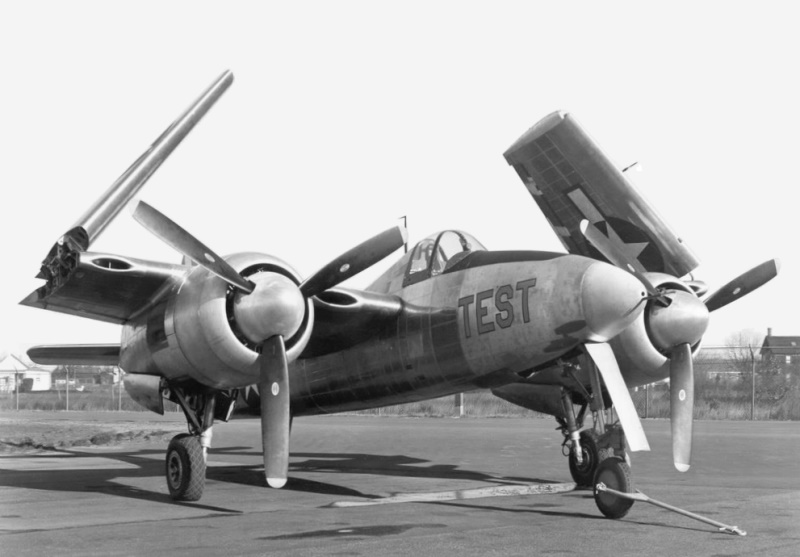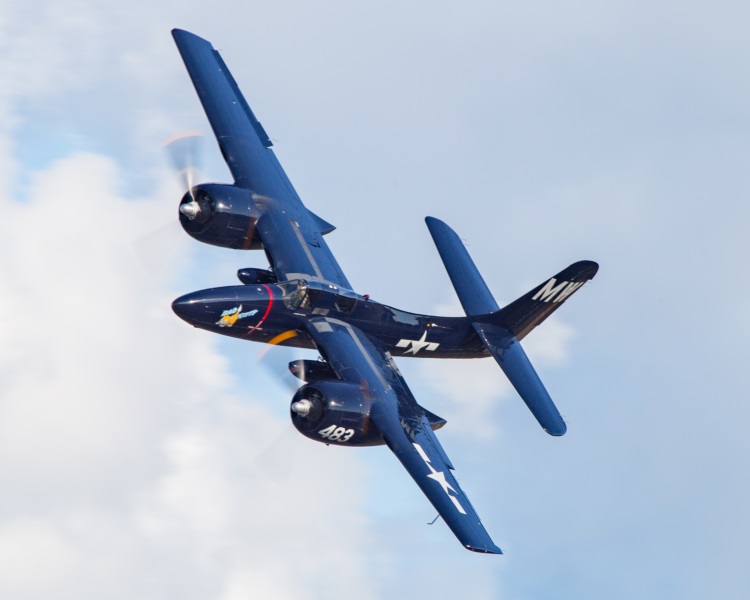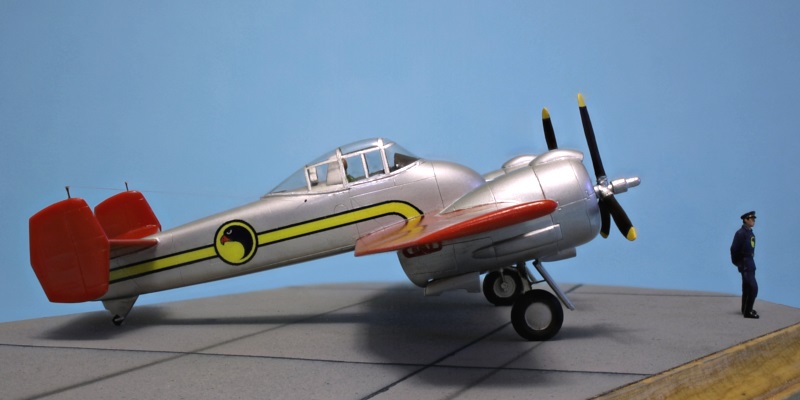
* Following the F4F Wildcat and F6F Hellcat single-engine carrier-based fighters, which proved important weapons for the Allies in World War II, the Grumman company went on to develop a twin-engine fighter, the "F7F Tigercat". It was too late to see real combat service in the conflict, and quickly was outdated by jet fighters emerging in the postwar era, but it was nonetheless an impressive machine. This document provides a history and description of the Tigercat -- as well as its predecessors, the Grumman "XF5F" and "XP-50". A list of illustration credits is given at the end.
* In 1935, US Navy BuAer began to consider the possibility of a twin-engine single-seat carried-based fighter. That was a departure for the Navy, which had never operated twin-engine fighters off carriers, but the twin-engine configuration offered the possibility of carrying heavier armament, or more fuel for extended range.
In 1937, the BuAer issued a request for proposals for such a fighter, with top speed to be in excess of 480 KPH (300 MPH). Brewster, Curtiss, Lockheed, Seversky (Republic), and Vought all submitted proposals in response. The Grumman proposal, the "Design 25", was powered by twin turbocharged Allison V-1710 inline vee-12 engines, the engine fit that would be selected for the Lockheed P-38 Lightning.
The BuAer was not particularly impressed by any of the submissions and decided to try again, issuing a requirement in early 1938 that specified a carrier fighter as either a single-engine fighter with a supercharged Allison inline, or a twin-engine fighter with supercharged radials. The fighter was to be armed with twin 20-millimeter cannon and twin 7.62-millimeter (0.30-caliber) Browning machine guns. Top speed was not specified, but the spec made it clear that performance would be an issue in the selection.
Bell, Brewster, Curtiss, Grumman, and Vought submitted proposals in response to the second request; Vought also submitted a design with a single Pratt & Whitney (P&W) R-2800 radial engine, even though that was not a configuration listed in the BuAer request. In April 1938, the Navy awarded a contract to Vought for the R-2800-powered machine, which was given the designation of "XF4U-1", and for the Grumman twin-radial "G-34", which was given the designation of "XF5F-1". In November, a third contract was awarded to Bell for the Allison-powered "XFL-1 Airbonita", a navalized version of the Bell P-39 Airacobra.
The XF5F-1 was originally supposed to be powered by twin P&W R-1535-96 Twin Wasp Junior two-row 14-cylinder air-cooled radials with two-speed superchargers, providing 560 kW (750 HP). However, P&W decided to discontinue the two-speed supercharger option on the R-1535, and so Grumman engineers switched to the Wright R-1820 radial engine. The problem was that the R-1820 was a single-row nine-cylinder engine, which meant it was not as deep as the R-1535 and was substantially wider. That meant wider nacelles, and so reduced the downward and forward field of view for the pilot. That was hardly optimum for a carrier-based fighter, but the Navy accepted the change.

The initial flight of the XF5F-1, or "Skyrocket" as it was named, was on 1 April 1940. It featured a low-mounted wing, with an engine in a nacelle on each wing, twin tailfins with the tailplane featuring noticeable dihedral, and a high-perched cockpit. It had taildragger landing gear, all gear assemblies featuring single wheels, the tailwheel being fixed and the main gear retracting backwards into the engine nacelles. The wings folded straight up. The powerplants were "handed" Wright XR-1820-40 and X-1820-42 engines, driving 3-bladed variable-pitch propellers that rotated in opposite directions to help reduce torque.
The nose of the XF5F-1 was very stubby, not even reaching the leading edge of the wing, giving the machine an odd and comic-bookish appearance. There were provisions for armament of four Danish 23-millimeter Madsen cannon in the nose, but the X5F5-1 was never actually fitted with armament.
___________________________________________________________________
GRUMMAN XF5F-1 SKYROCKET:
___________________________________________________________________
wingspan:
12.8 meters (42 feet)
wing area:
28.19 sq_meters (303.5 sq_feet)
length:
8.75 meters (28 feet 8 inches)
height:
3.45 meters (11 feet 4 inches)
empty weight:
3,675 kilograms (3,675 pounds)
loaded weight:
4,600 kilograms (10,140 pounds)
max speed at altitude:
610 KPH (380 MPH / 330 KT)
service ceiling:
10,000 meters (33,000 feet)
range:
1,930 kilometers (1,200 MI / 1,045 NMI)
___________________________________________________________________
The XF5F-1 was not a winner, the only thing impressive about it being a rapid rate of climb, hence the name. Along with technical problems such as difficulties with retracting the main landing gear and engine oil cooling, the aircraft was very "draggy", and as noted, the field of view was very poor. The prototype was delivered to the US Navy air test station at Anacostia in Virginia on 22 February 1941, but by that time the likelihood that it would enter production was very slight. The Vought XF4U-1 was already demonstrating excellent performance and the Navy was moving towards production of that machine, which would become the legendary Corsair; given the urgency of American re-armament at that time, there was no reason to bet on the Skyrocket.

However, the Navy was interested in seeing if the XF5F-1 could be improved. It was well slower than the XF4U-1, with a top speed of only about 610 KPH (380 MPH), but its climb rate was 50% faster, which suggested the Skyrocket wasn't all bad. Grumman implemented a number of fixes, including longer engine nacelles, prop spinners, a longer nose, wing fillets, and a lower canopy -- but trials from late July 1941 demonstrated no real improvement, and the Navy gave up on the XF5F-1. It was retained as a trials machine, to finally suffer an undercarriage failure on 11 December 1944; it was written off and scrapped.
* In 1939, the US Army Air Corps had issued a requirement for an advanced piston fighter, to be based on an existing fighter design but with more powerful engines. Four companies submitted proposals; Grumman's offering as the "G-41", which was derived from the XF5F-1, but featured Wright Cyclones with turbochargers.
The Lockheed submission was the "Model 522", which was a derivative of the Lockheed P-38 Lightning, itself still in prototype trials, with either Pratt and Whitney XH-2600 or Wright R-2160 turbocharged inline engines. The Model 522 won the competition, being ordered by the Air Corps as the "XP-49", though it would never enter production. However, the Army saw the Grumman G-41 as interesting enough to be investigated as a backup, with the company submitting a revised design, the "G-45", with tricycle landing gear and a longer nose that stretched length to 9.73 meters (31 feet 11 inches). In late November 1939, the Air Corps ordered a single prototype as the "XP-50".

The initial flight of the XP-50 was on 18 February 1941, with Grumman test pilot Bob Hall at the controls. It was powered by twin turbocharged Wright R-1820-67/69 radials providing 895 kW (1,200 HP) each. Armament was to be two 20-millimeter cannon and two 12.7-millimeter Browning machine guns, with all four weapons mounted in the nose. Handling and performance proved superior to that of the XF5F-1 -- but on 14 April 1941, one of the turbochargers exploded while the XP-50 was over Long Island sound. Hall bailed out safely, but of course the machine was a loss. It had flown for only about 20 hours. The Army had no interest in contracting another prototype, and that was the end of the program.
BACK_TO_TOP* Although the SkyRocket had been a bust, both the Navy and Grumman remained interested in the concept of a twin-engine heavy carrier fighter. In early 1941, taking the lessons of the XF5F-1 to heart, a Grumman engineering team began work on what would end up a "clean sheet" twin-engine carrier fighter, then referred to as the "G-51 Tigercat". The major influence the Skyrocket had on the Tigercat, it seems, was as a bad example.
At the end of June 1941, the BuAer awarded Grumman a contract for two prototypes, to be designated "XF7F-1". Initial flight of the first prototype was in December 1943. Even before the prototypes took to the air, Grumman had received a contract for 500 production "F7F-1" aircraft, to be used by the US Marines in the fighter-bomber role. The first was delivered in April 1944, with 33 more following. Incidentally, the first XF7F-1 prototype was damaged in an accident and written off.

The F7F-1 was as sleek as the Skyrocket had been quirky. The Tigercat was of all-metal construction and had a slender fuselage, with the pilot sitting under a "razorback"-style cockpit that slid rearwards to open. The flight surface layout was conventional, the wings being mid-mounted. A P&W R-2800-22W Double Wasp radial, providing 1,565 kW (2,100 HP), was mounted on each wing -- the engines featuring water-methanol injection to provide redline boost power, and driving three-blade variable-pitch Hamilton Standard props. The prototypes had oversized prop spinners, but they were deleted in production, possibly to improve engine cooling. The wings folded up just outside of the engines.
There were four 20-millimeter Hispano cannon in the wing roots and four 12.7-millimeter M2 machine guns in the nose. There was a single "wet" centerline hardpoint that could be used to carry an external fuel tank or offensive store, and a total of four underwing hardpoints, one inboard of each engine, another outboard. Four stub launchers for 12.7-centimeter (5-inch) "high velocity aircraft rockets (HVAR)" could be attached to each outer wing in place of an outer wing pylon, for a total load of eight rockets, along with a store on each inboard pylon. Total external load could be up to 1,815 kilograms (4,000 pounds).
The Tigercat featured tricycle landing gear, all with single wheels, all gear retracting backwards, the main gear tucking into the engine nacelles. There was a stinger-type arresting hook under the tail. The cockpit design was derived from that of the F6F Hellcat, the cockpit being regarded as comfortable and roomy, with an excellent field of view.
The F7F-1 proved to have an impressive climb rate -- at low altitudes, it could outclimb an F6F Hellcat or F4U Corsair -- and was surprisingly agile for a machine of its size, one pilot claiming that he had entirely outflown a P-51D Mustang and a P-47N Thunderbolt in mock combat at low altitude. However, although the Tigercat was rock-stable and did not spin easily, it could not be easily recovered from a spin when it did; in addition, the hydraulic boost system for the rudder led to a degree of yaw instability, and landing with an engine out required unpleasantly high speed. Incidentally, with both engines out, it had the glide characteristics of a brick.
Early F7F-1s also tended to be damaged on a carrier smackdown, though such problems would be fixed. Nonetheless, the Navy's conclusion was that the Tigercat was too big and too "hot" for carrier operations. The Tigercat would eventually be fully qualified for carrier operations, but never normally used in such. The inclination was then to hand it to the Marines for shore-based operation, starting out with a night-fighter variant. The 35th machine on the F7F-1 production line was modified as a prototype for the "XF7F-2N", with the next 65 machines rolled out being "F7F-2N" night fighters. They featured a rear cockpit for a radar operator, fuselage fuel tankage being reduced to make space for it, and an SCR-720 radar in a long "snout" nose. The four M2 machine guns were deleted to make space for the radar, leaving the four 20-millimeter cannon. A small strake was also added underneath the rear fuselage.

* The next model of the Tigercat off the Grumman production line was the "F7F-3", which was an improved F7F-1 single-seat day fighter with uprated R-2800-34W Double Wasp radials, providing 1,565 kW (2,100 HP) each; a distinctly larger tailfin; and 7% more fuel capacity. 190 were built, with orders for more on the books, but the end of the war led to production being cut short.
___________________________________________________________________
GRUMMAN F7F-3 TIGERCAT:
___________________________________________________________________
wingspan:
15.7 meters (51 feet 6 inches)
wing area:
42.27 sq_meters (455 sq_feet)
length:
13.83 meters (45 feet 4 inches)
height:
5.05 meters (16 feet 7 inches)
empty weight:
7,380 kilograms (16,270 pounds)
MTO weight:
11,665 kilograms (25,720 pounds)
max speed at altitude:
700 KPH (435 MPH / 380 KT)
service ceiling:
12,400 meters (40,700 feet)
range:
1,930 kilometers (1,200 MI / 1,045 NMI)
___________________________________________________________________
However, the Marines had a need for more night-fighters, and so an order was placed for a batch of "F7F-3Ns", which were effectively F7F-3s with F7F-2N night-fighter kit. 60 were built, followed by 13 "F7F-4Ns", which featured structural strengthening to make them better suited to carrier operations.

Some F7F-3Ns were field-modified to "F7F-3P" photo-reconnaissance platforms, and there were also some conversions to "F7F-3D" drone director aircraft, with a canopy taken from a Grumman F8F-8 Bearcat fighter tacked onto the spine for the drone controller in the back seat. Some sources also mention conversions to "F7F-3E" electronic warfare platforms, but it is hard to find any details or images.

The Tigercat fought in the Korean War in the night-fighter role, though it was withdrawn from combat in 1952, and was out of military use by the mid-1950s. However, in the 1960s, some were converted to "water bombers" for fighting wildfires by being fitted with a belly tank for water or fire retardant. The Tigercats could not carry as large a load as four-engined aircraft, but they could reach the fire much more quickly. A few Tigercats remain in flight condition, performing tours on the airshow circuit.
BACK_TO_TOP* The XF5F-1 was a dead-end machine, but ended up having a peculiar distinction, since it was used as the mount for the "Blackhawks", a team of comic-book aces who took on the Axis powers and other villains, flying colorful Skyrockets with hawk's head insignia. The Blackhawks still make occasional nostalgia appearances in comics, flying more modern aircraft, and modelers are fond of trimming up Skyrocket kits with Blackhawk colors.

* Sources include:
* Illustrations details:
* Revision history:
v1.0.0 / 01 jul 16 v1.0.1 / 01 jun 18 / Review & polish. v1.0.2 / 01 may 20 / Review & polish. v1.0.3 / 01 mar 22 / Review & polish. v1.0.4 / 01 dec 22 / Review & polish. v1.0.5 / 01 jan 23 / Review & polish. v1.0.6 / 01 jan 25 / Review & polish. (*)BACK_TO_TOP
